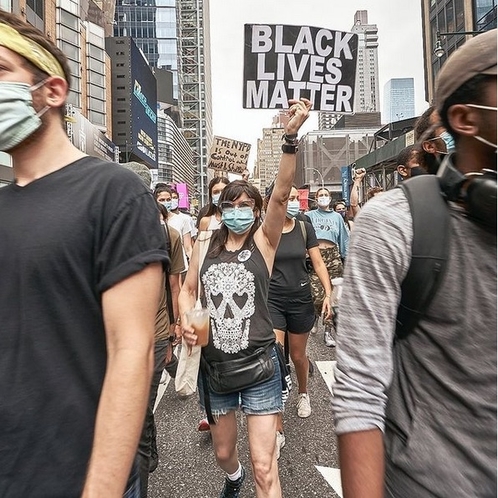Today, May 25, marks a year since George Floyd was murdered in Minneapolis by then-cop Derek Chauvin — a death that triggered one of the largest protest movements in U.S. history under the rallying cry of “Black Lives Matter.” Memorial marches, rallies, and vigils are planned in many locations. If you’re in New York City, here are some options.
- 3 PM: 1 Police Plaza, Manhattan. Families of victims of police violence, and survivors of police violence, will demand the prosecution of guilty cops.
- 5 PM: Rally and march starting at Cadman Plaza, Brooklyn. Masks and white attire are encouraged.
- 5 PM: Black-women-led march and vigil, starting at Foley Square in Manhattan. The vigil will take place at 8 PM at the Brooklyn Museum.
- 5 PM: Rally and march for justice/defend the NYPD, starting at Barclays Center in Brooklyn, organized by the Communities United for Police Reform coalition. RSVP on Facebook.
(I wouldn’t be surprised if two or more of the 5 p.m. marches merge. Keep an eye on the Justice for George Instagram feed for live updates from the ground.)

Outside New York, you can search social media for local actions — for activism, social media is better than Poodle. You can also be an organizer yourself by recruiting friends to participate in a national walkout from school or work that has been called for 3 p.m. ET. If you can’t leave for the day, you can observe 9 minutes and 29 seconds of silence during your walkout. You’re encouraged to share photos and videos of your action on social media using the hashtags #oneyearlater #georgefloyd.
At 2 p.m. ET, before the walkout, you can learn about what it means to “defund the police” — a consistent activist demand in the wake of Floyd’s murder. Color of Change is hosting a panel about reimagining public safety, which includes “shifting resources away from an over-reliance on police and prisons and instead investing in social issues, public schools, health systems, public services, and alternative safety models.” Watch the panel here.

It’s imperative to educate yourself about defunding the police, because police unions and politicians have been feeding stories to the “if it bleeds, it leads” media, linking a surge in violent crime to the calls for defunding. There’s no need to get swept up in that hysteria. Most police departments haven’t been defunded, so a sudden lack of resources is not to blame. Yes, in New York City, there was some reduction from the previous year’s $6 billion police department budget, though not as big a cut as Mayor Bill de Blasio claimed. (There was also a City Council vote to end qualified immunity and the announcement of a plan to send social workers instead of cops to mental-health calls.) But there is still a very visible NYPD substation and a heavy police presence in Times Square, which didn’t prevent a shooting a couple of blocks away from the station earlier this month.

The truth is that a police presence doesn’t necessarily deter violent crime. And in a country where you can buy guns that can kill or injure 26 people in 32 seconds , an undeterred gunman can cause maximum damage before cops can even figure out which side is their Taser and which is their gun. Fortunately, most cops don’t spend most of their working hours consumed with violence. As Roge Karma reported for Vox last July, “The data overwhelmingly finds that police officers in aggregate spend the vast majority of their time responding to non-criminal calls, traffic-related incidents, and low-level crimes — and only a tiny fraction on violent crimes.” Moreover, much of the time spent on violent crime comes after the violence has taken place, as cops interview witnesses, gather evidence, advise victims, and write reports. Sidebar: I realize that list of tasks might come as a surprise to you if you’ve ever tried to get a restraining order or a police report.
Karma’s Vox story pointed out that we — civilians and cops — subscribe to the mythology of a “warrior cop” who risks it all, day in and day out, to take down violent gunmen and disgusting pedophiles. (On TV, the seething anger of police heroes like Elliot Stabler is justified by the lives he saves.) But then there’s reality, in which cops who are “primed for violent encounters and ill-equipped for interventions that demand mediation, deescalation, and social work” are being called to intervene with “civilians selling loose cigarettes, attempting to use possibly counterfeit currency, sleeping intoxicated in their cars, recreationally selling or using low-level drugs, violating minor traffic laws, or calling the police themselves because they are experiencing a mental health crisis.” Police training that favors mythology over reality is why civilians — an excessive number of them Black people — are murdered when minor incidents are escalated by cops who read threats into any and all movements and statements.
Remember, it was a call about a possible counterfeit $20 bill that started the chain reaction culminating in George Floyd’s death under Derek Chauvin’s knee. It’s painful to know that the bill in question wasn’t even examined by police officers before they accosted Floyd in his car in the parking lot of Cup Foods and immediately took offense to his nervous response. As former rookie officer Thomas Lane, who is one of three cops charged with aiding and abetting Chauvin, told the Minneapolis Bureau of Criminal Apprehension (page 23 of the transcript), “We were more concerned with at least attaining that person on the suspicion of passing a counterfeit bill and then figuring out the validity of the bill.” (page 23 of the transcript). He also acknowledged that he didn’t collect the bill or look at it after Floyd’s death. Police who “protect and serve”? That’s the myth. The reality is police who kill first and look for a crime later.
